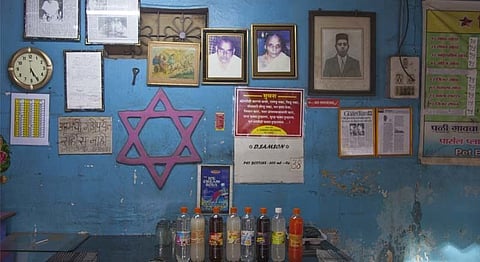
- HOMEGROWN WORLD
- #HGCREATORS
- #HGEXPLORE
- #HGVOICES
- #HGSHOP
- CAREERS
- ABOUT US
- CONTACT US

The first thing I notice when I walk into D Samson’s Soda joint is a group of old men drowning themselves in fervorous laughter and glasses of ice cream soda. It is late in the afternoon and the rays of the setting sun filter through the end-to-end grilled window of the tiny space, throwing light on their wrinkled, happy faces. They occupy the corner table just beside the picture of Moses that hangs on a blue wall inscribed with a pretty, pink Star of David — perhaps the only remnant of a time that once was.
Within mere minutes of me walking in, the group of men have gotten up to pay for their sodas. The cashier greets them informally, with tones that suggest they’re more than acquaintances; this is a relationship that has been built over the years. It is then that I politely interrupt one of the men, who goes by the name Shreekrishna Patil, asking him about D Samson’s soda and what it means to him.
It doesn’t take him long to respond. “I am 78 years old and my friends and I have been coming here since our childhood. This has been our go-to place... after school, after college, after work and now after pension meetings,” he says, looking at his friends and chuckling. “The place has hardly changed. It is just what it was like when we were children,” he adds with a nostalgic glint in his eyes.
Tired and thirsty for a soda and story, my research on the Benne Israeli community of Alibaug is what brought me to this quaint beverage place situated in Pali, near Alibaug. It serves as a monument to the Benne Israeli community that set up the villages in the area which was their home centuries ago; intermingling with the Maharashtrians without letting go of their roots.
One of them by the name of Daniel Samson Digodkar (first name signifies his Jewish connect, while his last name Digodkar is acquired from his village Digdo near Mandwa) who was fond of aerated beverages established this now-iconic soda joint in 1938 after his mills shut down.
These fizzy drinks were a favourite amongst the British and D’Samson’s started off by offering unique sodas like Ginger Lemon, Kala Khatta, Masala and their most loved, the Ice Cream Soda. After his death, his sister Sydney Moses started overseeing the operations.
As of now, it is run by her son, 59-year-old Daniel Sydney who has been very fond of his uncle’s sodas and decided as a young child that he wanted to continue this business after him. “There is no secret recipe for the drink. Lots of companies have tried this formula but could not achieve the same taste which D.Samson has got,” David tells me. D Samsons had Soda machines that were imported back in the day from Europe.
Today they use the ones that are locally made, with absolutely no difference in the taste. I see the soda machines in the same compound, being operated by a middle-aged man. His hands work like magic as he quickly fills one bottle after the other and infuses them with lids.
I order a glass of Ice Cream Soda while my colleagues settle for Ginger Lemon and Kala Khatta. As with every soda, the fizz tickled my nose before I take a sip. I braced myself for an overly sweet taste but D Samson had his recipe down pat.
A flavour distinctively reminiscent of my own childhood (a colleague back in the office later pointed out that the aftertaste was akin to that of Calcium Sandoz, and I found it hard to disagree), it soon became clear to me why this fizzy delight was so easy to down in a couple of minutes. The zesty Ginger Lemon was a pleasant refresher while the Kala Khatta was more of a fruity delight, one that we deemed fit to make a rather interesting cocktail.
For only INR 15 each, we sipped on our sodas at a snail’s pace compared to the many locals who stopped by for a quick glass. After an entire day’s travel, this was perhaps the perfect note to end it on. We even purchase some packaged soda bottles to introduce our friends and family to this legendary soda with a Jewish connection.
As I sit there sipping on the drink, I realise how D Samson is a strange enigma of time, colour and multiculturalism. Konkani architecture with a Marathi signboard, a blue wall with a pink Star Of David, a sepia-tinted picture of Moses, besides that of Daniel Samson and his sister; hosting travellers from around the country who occupy rickety classroom-like benches alongside locals.
For them, it’s a daily affair unlike us travellers who spend some time, understanding the place by looking at the pale blue walls that are doted with not just newspaper clippings of pompous press coverage but are also the symbol of a unique cultural legacy that comes alive proudly, through their soda.
It is much more than a casual soda joint that quenches the thirst of travellers. It is, in fact, a representation of an entire community – a unique hybrid born out of interesting historical events and the seamless intermingling of cultures, who have quietly made their place in the heart of the state, just like their soda has, in the hearts of its people.
All photographs taken by Rashi Arora for Homegrown
If you enjoyed reading this article, we suggest you read:
